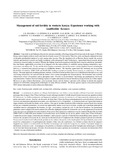Management of soil fertility in western Kenya: Experience working with smallholder farmers

View/
Date
2005Author
Okalebo, JR
Othieno, CO
Maritim, HK
Iruria, DM
Kipsat, MJ
Kisinyo, PO
Kimenye, LM
Woomer, PL
Mukhwana, EJ
Batiano, A
Adipala, E
Njoroge, RK
Thuita, M
Nekesa, AO
Ruto, EC
Language
enMetadata
Show full item recordAbstract
Crop yields in sub-Saharan Africa are low and unsustainable, reflecting prolonged food insecurity in the region. In Western
Kenya, maize (staple) yields at small scale farm level rarely exceed 0.5 t/ ha/ season. These low yields are largely explained in terms
of droughts and depleted nutrients in soils, among other reasons. Thus the farmland soils in Western Kenya, mainly the acrisols
(utisols) and ferralsols (oxisols) are highly weathered, with widespread N and P deficiencies. Agricultural-based research during
colonial rule focused studies on-station. Whereas the findings from such research provided the basic concepts underlying constraints,
they had limited applicability at on-farm level, plagued with the main problem of variability among farming communities, agroecosystems,
including soils. To this end the donor/ partner community stressed the need to conduct applied research including the
delivery of extension and outreach messages to smallholder farmers. We therefore appreciated this sentiment and received the
Rockefeller Foundation, TSBF-CIAT and KARI-ARF funding to install soil fertility based research on small farms in Western
Kenya. Our team approach, including graduate students, consisted of initial problem (poor soils) identification through surveys and
soil testing, followed by site selection and the farmer’s involvement throughout the research period. We formulated and tested the
effectiveness of low cost products such as phosphate rocks. Overall, we found farmers’ knowledge and participation vital in our
experimentation. Farmers observed striking responses to inputs and realized economic benefits accruing from the use of these inputs.
However, in spite of these illustrations, socio-economic factors and the farmer’s priorities will continue to dictate the targeted
adoption of soil fertility management technologies in many African countries. We discuss general aspects of research-extension/
NGO-farmer interactions towards enhanced collaboration.
Citation
African Crop Science Conference Proceedings, Vol. 7. pp. 1465-1473Publisher
African Crop Science Society
